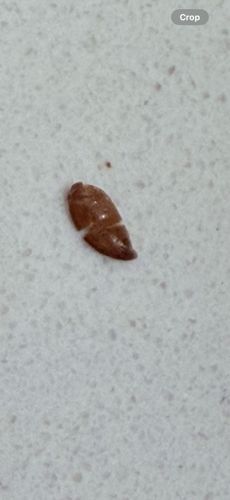Moth Pupa / Case-bearing Moth Larva
Scientific Name: Varies depending on exact species (e.g., Plodia interpunctella for Indianmeal Moth, Tineola bisselliella for Common Clothes Moth)
Order & Family: Lepidoptera (Moths and Butterflies) / Tineidae (Clothes Moths, Case-bearing Moths) or Pyralidae (Snout Moths, including Pantry Moths)
Size: Typically 6-15 mm (0.24-0.6 inches) in length for the pupa/cocoon, varying by species.

Natural Habitat
Indoors, especially in kitchens, pantries, closets, and storage areas where food items or natural fibers are present. They prefer dark, undisturbed locations.
Diet & Feeding
The image appears to be a pupal casing (cocoon) of a moth, or possibly a larva of a case-bearing moth. If it's a moth pupa, it typically does not feed. If it's a living case-bearing moth larva inside its case, their diet depends on the species, but common types like pantry moths or clothes moths feed on dried food products (grains, cereals, dried fruits) or natural fibers (wool, silk, fur).
Behavior Patterns
Larvae develop within their cocoons into pupae. This pupal stage is non-feeding and precedes the emergence of the adult moth. They are often found in dark, undisturbed places, such as inside pantries or wardrobes.
Risks & Benefits
Potential risks include damage to stored food items (contamination and consumption) and destruction of natural fiber goods (clothes, carpets, upholstery). They pose no direct health risk to humans (do not bite or sting) and offer no significant benefits in a domestic setting.
Identified on: 8/17/2025